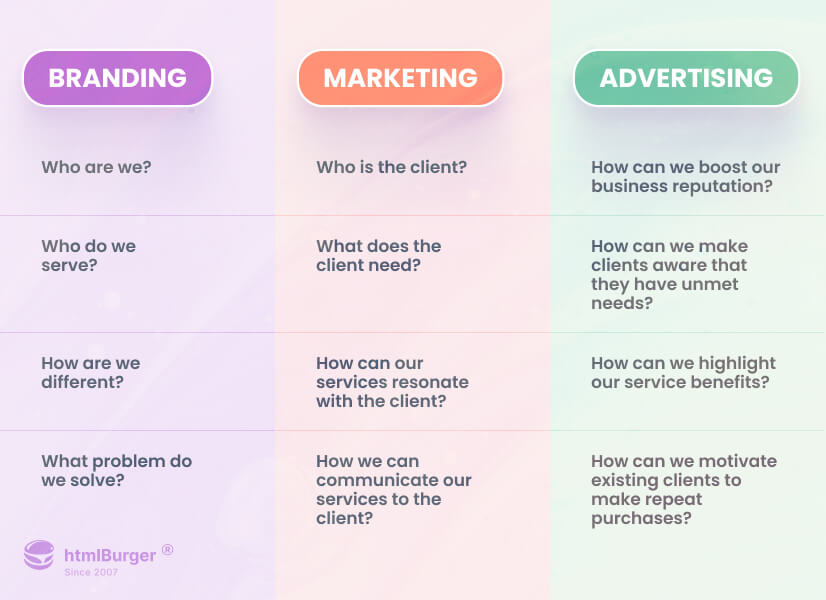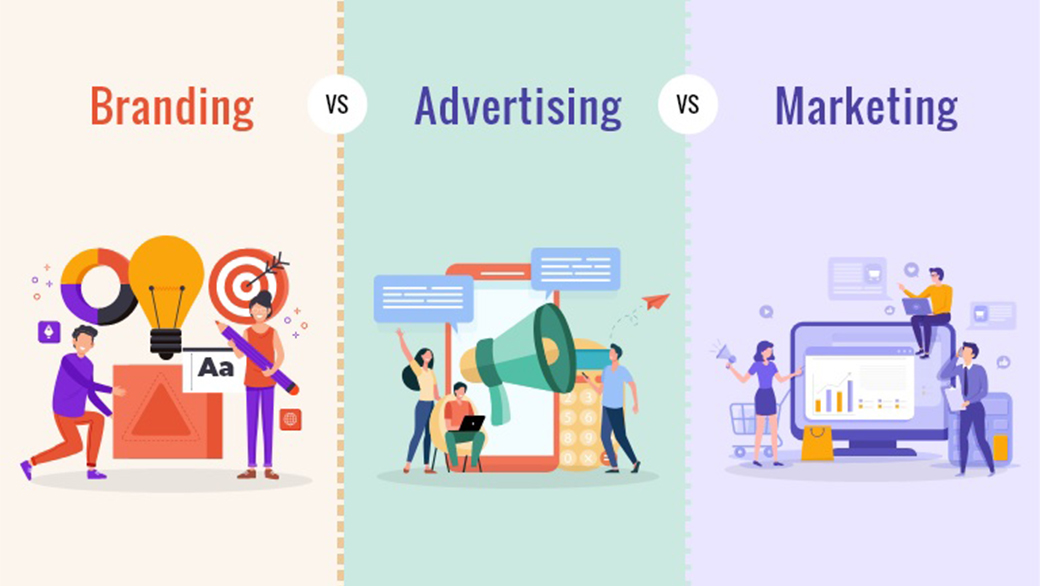Branding, Marketing, and Advertising: What’s the Difference?
The terms branding, marketing, and advertising are often used interchangeably. However, each plays a distinct and essential role in helping businesses grow and succeed. Understanding the differences between them is crucial for creating an integrated strategy that drives long-term success.
There are distinctions between branding, marketing, and advertising, highlighting their importance, the strategies behind them, and how they can collectively elevate your business. Let’s explore how effective branding, marketing, and advertising work together to build a thriving business.
- Branding, Marketing, and Advertising in a Nutshell
- Branding, Marketing, and Advertising Defined
- Branding vs. Marketing vs. Advertising: Key Differences
- Successful Brand Advertising Campaigns to Learn From
- 5 Key Strategies for Effective Brand Advertising
- Invest in Branding, Marketing, and Advertising
- Questions This Blog Answers
- Key Takeaways
Branding, Marketing, and Advertising in a Nutshell
Although branding, marketing, and advertising share a common goal—business growth—each has a unique role. Branding is the foundation, shaping the identity and personality of your business. Marketing communicates your message to the right audience, while advertising amplifies that message through paid channels. When done well, these three components work in harmony to build awareness, trust, and customer loyalty.
In 2023, businesses spent over $270 billion on social media marketing and advertising campaigns. Why? Because these strategies work! Let’s explore why that is.
Branding, Marketing, and Advertising Defined
Branding: The Core of Your Business Identity
Branding is the very foundation upon which your business is built. It is the definition of who you are as a company, what values and beliefs you stand for, and how you connect emotionally with your audience. Effective branding establishes a unique identity that sets your business apart from competitors and resonates deeply with your target market. It’s more than just logos, color schemes, or catchy slogans—it’s about the entire experience a customer has with your company.
A strong brand can evoke emotions, influence perceptions, and create an undeniable connection. For example, imagine you’re presenting a set of toys to a child—dolls, trucks, action figures—and among the options, the child gravitates toward the Superman action figure. At first glance, it might seem like the child is merely selecting a toy, but in reality, the child is choosing an identity. The red “S” logo isn’t just a design; it represents strength, courage, and heroism—qualities the child likely aspires to or identifies with. This emotional pull is the essence of strong branding. It taps into the psychology of what a brand symbolizes and aligns with a customer’s aspirations, values, or desires.
Without clear and consistent branding, a business risks becoming forgettable or blending into the sea of other companies offering similar products or services. Brand consistency is key—every interaction, whether through your website, social media, or customer service, must align with your brand’s message and identity. Brand consistency fosters trust, recognition, and long-term loyalty. For example, brands like Coca-Cola have mastered this by maintaining a consistent identity across all channels, from their visual branding to their messaging, and even the emotions they evoke in their consumers. Strong, consistent branding makes it easier for customers to choose you and, ultimately, remember you.
Marketing: The Strategy That Drives Awareness and Engagement
Once your brand identity is firmly established, marketing steps in to communicate that brand to your target audience. Marketing is the action—the set of tools, tactics, and strategies you use to spread your brand message and engage with potential customers. It includes everything from market research and content creation to social media management, product development, and influencer marketing.
An effective marketing strategy begins by identifying the needs and desires of your target audience. Understanding what drives your customers, what challenges they face, and what motivates their decisions is critical. For example, a well-crafted content marketing strategy can help educate your audience on the benefits of your products or services, while also creating valuable content that speaks directly to their pain points. Whether it’s blog posts, social media updates, video content, or email campaigns, marketing allows you to craft your messaging and provide solutions that resonate with your audience.
Another key aspect of marketing is the customer journey. Successful marketing doesn’t just attract attention; it nurtures curiosity, builds relationships, and ultimately influences purchasing decisions. For example, email marketing campaigns can be used to follow up with leads, offer valuable insights, or highlight new product launches, moving potential customers down the sales funnel. Marketing is about creating an ongoing dialogue with your audience, consistently providing value, and building trust over time. As brands continue to diversify their approaches, a well-executed marketing strategy can also incorporate influencer marketing, partnerships, or referral programs, which help expand your reach and solidify your position in the market.
Advertising: Amplifying Your Reach Through Paid Media
While branding and marketing are essential for laying the groundwork and building relationships, advertising comes in as the powerful amplifier that helps extend your reach and accelerate your visibility. Advertising allows you to reach new customers and reinforce your brand’s message through paid media. Whether it’s through digital ads on social media platforms, search engine results, television, radio, or print ads, advertising puts your message in front of a wider audience in a targeted, strategic way.
One of the key benefits of advertising is its ability to reach people who might not yet know about your brand. Unlike organic marketing efforts that rely on attracting and nurturing leads over time, advertising allows you to target specific demographics, behaviors, and interests, ensuring that your message reaches the right people at the right time. Paid media can amplify the effects of your marketing strategy, driving traffic, increasing sales, and ultimately improving brand awareness.
For example, digital advertising through platforms like Google Ads or Facebook Ads gives businesses the opportunity to target users based on their search history, interests, or behaviors, ensuring that your ads are relevant to the audience seeing them. Research also shows that 49% of consumers are influenced by advertisements when making purchasing decisions, further highlighting the effectiveness of paid advertising. (Source: Business Insider) Additionally, digital ads allow businesses to continuously test and refine their messaging, optimizing for performance based on data-driven insights.
While advertising can be an effective tool for boosting short-term sales or awareness, it’s important to remember that it works best when integrated with your broader marketing and branding strategies. Advertising isn’t just about pushing products; it’s about reinforcing the messages your brand stands for, maintaining consistency with your marketing content, and driving home your brand’s core values.
The Synergy of Branding, Marketing, and Advertising
While each of these three elements—branding, marketing, and advertising—serves a unique function, they are most effective when working together in harmony. Branding establishes the identity and emotional connection with your audience. Marketing crafts the strategy and message that communicates that identity, nurturing curiosity and trust. Finally, advertising amplifies those efforts, pushing your brand message out to a broader audience through paid channels to increase reach and drive action.
When executed correctly, the combination of all three can lead to lasting customer loyalty, brand authority, and sustained growth. Whether you’re just starting to build your brand or looking to refine your marketing and advertising strategies, understanding how each of these elements plays a role in the customer journey is essential for success.
The Role of Advertising
In today’s digital age, advertising is evolving rapidly. With the rise of social media, programmatic ads, and influencer marketing, brands now have a myriad of ways to reach their target audience. You can see how advertising serves as a vital element to increase the impact of your brand marketing efforts.
Branding vs. Marketing vs. Advertising: Key Differences
Now that we’ve defined the roles of branding, marketing, and advertising, it’s important to understand how these three elements differ in terms of their purpose, goals, and overall impact on a business. While they all work together to promote growth, each plays a distinct role in shaping how a business engages with its audience and builds long-term success. Branding is the foundational layer, influencing how customers perceive your business, fostering trust, and creating a unique identity. Marketing focuses on communicating the value of your brand to the right audience through strategic messaging and engagement. Advertising, on the other hand, serves as the amplifier, pushing your message further with paid efforts designed to maximize visibility and reach. Understanding the nuanced differences between these three concepts will help you align your business strategies more effectively and create a cohesive approach that delivers results.
Successful Brand Advertising Campaigns to Learn From
1. Budweiser Whassup Quarantine Version
Challenge: The COVID-19 pandemic made people feel more isolated, making it essential for brands to create a sense of connection.
Solution: Budweiser revived their famous Whassup ad with a quarantine twist, encouraging people to check in on their loved ones. The campaign captured the nostalgia of the original ad, while adapting it to the new reality of isolation.
2. Colgate’s Sonic Branding
Challenge: Colgate wanted to create a more emotional connection with their customers through music.
Solution: By collaborating with neuroscientists, Colgate developed a specific sound associated with positivity, happiness, and joy—attributes that align with their brand. This auditory branding helped elevate the emotional impact of their ads.
5 Key Strategies for Effective Brand Advertising
1. Understand Your Competitors
Conducting competitor analysis is essential for refining your own strategies. By understanding your competitors’ strengths, weaknesses, and positioning, you can identify opportunities to differentiate your brand.
For more on competitor analysis, check out this Harvard Business Review article on Competitive Strategy.
2. Create Your Brand Persona
Your brand persona is the humanization of your brand—its values, mission, and voice. Think of it as the “personality” of your brand that customers can relate to. For example, IKEA positions itself as practical, affordable, and environmentally conscious.
3. Refine Your Advertising Content Regularly
Keeping your content fresh is key to staying relevant. Regular content audits help you assess what’s working and what needs improvement. Adjust your strategies based on performance data to ensure your ads continue to resonate with your audience.
4. Choose the Right Marketing Channels
Don’t spread yourself too thin. Instead, focus on the marketing channels that best match your target audience’s preferences. Use tools like surveys or social listening to understand where your customers engage most frequently. Learn more about choosing the right channels from this Forbes article on marketing strategies.
5. Leverage Influencers and Micro-Influencers
Influencer marketing is booming. As of 2021, the influencer marketing industry was worth $13.8 billion, and it’s expected to continue growing. The key is to choose influencers whose personal brand aligns with your values and resonates with your target audience. For more on influencer marketing, visit Influence.co.
Invest in Branding, Marketing, and Advertising
Success doesn’t happen overnight. Investing in your brand identity, marketing strategy, and advertising efforts can lead to sustainable growth and increased brand loyalty. A holistic approach to branding, marketing, and advertising is crucial. Each of these elements plays a distinct role, but their true power is realized when they work together seamlessly. Branding lays the foundation by defining who you are as a company, shaping your identity and emotional connection with your audience. Marketing then takes this identity and strategically communicates it, nurturing relationships and guiding customers through their journey. Advertising, on the other hand, acts as the amplifier, driving awareness and visibility to a broader audience through targeted paid media. When these three components align and support each other, they create a consistent, unified experience for customers that builds trust, drives engagement, and ensures long-term success.
A fragmented approach, where branding, marketing, and advertising operate in silos, often leads to inconsistent messaging and missed opportunities. Customers today are savvy, and they can easily spot brands that aren’t aligned across different touchpoints. To truly stand out and build lasting relationships with your audience, it’s essential that your brand’s message, tone, and visual identity are consistently reflected across all marketing and advertising channels. By integrating these efforts, businesses can craft a cohesive narrative that not only attracts customers but also turns them into loyal advocates. Embracing a holistic strategy enables businesses to create meaningful connections, drive growth, and sustain their competitive edge in a fast-paced, ever-evolving market.
Ready to take your brand to the next level? Connect with our team to learn how a holistic approach to Branding | Marketing | Advertising can elevate your business and drive measurable results. Let’s create a strategy that resonates with your audience and stands out in a crowded marketplace!
Questions This Blog Answers
- What is the difference between branding, marketing, and advertising?
- Why is branding important for a business?
- How can advertising amplify a brand’s reach?
- What are some examples of successful brand advertising campaigns?
- What are key strategies for effective brand advertising?
Key Takeaways
- Branding is the foundation of a business, shaping its identity and creating emotional connections with customers.
- Marketing communicates your brand’s message through various strategies to engage and nurture customers.
- Advertising amplifies your marketing efforts through paid media to reach a broader audience.
- Successful advertising campaigns often tap into emotions, nostalgia, and cultural relevance to resonate with consumers.
- Regularly refining your advertising and marketing strategies is key to staying relevant and competitive in a fast-paced market.
By understanding the distinctions and synergies between branding, marketing, and advertising, businesses can develop more effective, integrated strategies that drive success.




